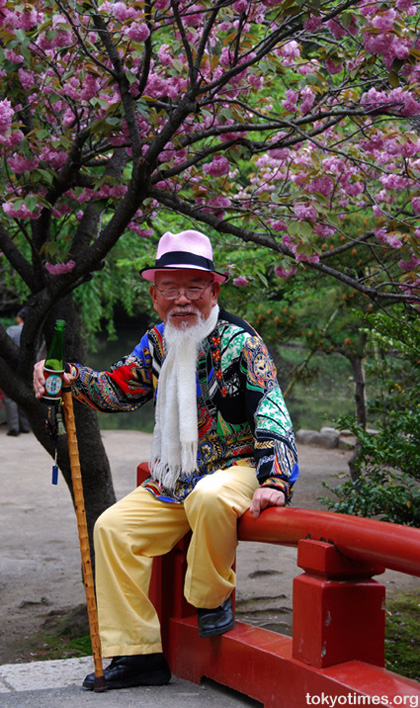
A few facts about Japan:
Japan has the oldest population among major countries, according to new figures from the US Census Bureau.
In total, 22 per cent of the Japanese population is aged 65 and over.
As well as this, the bureau has revealed that by 2050, the number of Japanese people who are aged 100 and above will have risen to 627,000, which the equivalent of almost one per cent of its population.
People born in Japan can now expect to live until around 82.
A low birth rate in the country will also lead to a rise in the median age, which is expected to go from 37 in 1990 to 55 by 2050.
Japan’s elderly people should keep working to pay taxes as their only talent is the ability to work, Prime Minister Taro Aso said on Saturday, risking anger from senior voters ahead of a key election.
Addressing young entrepreneurs in Yokohama, near Tokyo, Aso noted that more than 80 percent of people aged 65 or older in Japan were able-bodied and needed no nursing care.
“Please think these people are talented only in working, unlike you,” Aso said in a televised speech.
“It’s too late to learn playing around at over 80… If they use their working talent more and become workers, they will be taxpayers,” he said.
Daniel Gross In Slate:
Such a decline is cataclysmic for an indebted country that values infrastructure and personal service. (Who is going to maintain the trains, pay for social benefits, slice sushi at the Tsukiji fish market?) The obvious answers—encourage immigration and a higher birthrate—have proved difficult, even impossible, for this conservative society. In the United States, foreign-born workers make up 15 percent of the work force; in Japan, it’s 1 percent. And, official protestations to the contrary, they’re not particularly welcome. One columnist I met compared the standard Japanese attitude toward immigrants to that of French right-winger Jean-Marie Le Pen. In the 1990s, descendants of Japanese who had emigrated to South America early in the 20th century returned to replace retiring factory workers. Now that unemployment is on the rise, Japan is offering to pay the airfare for those who wish to return home.
Japan doesn’t particularly want to import new citizens, but it doesn’t seem to want to manufacture them, either. It’s become harder to support a family on a single income, and young people are living at home for longer. And Japan isn’t particularly friendly to working mothers—pre-K day care is not widely available, and the phrase work-life balance doesn’t seem to have a Japanese translation. (The directory of the Japanese Business Federation, a showcase of old guys in suits, makes the Republican Senate caucus look like a Benetton ad.) The upshot: a chronically low birthrate. Too often, demographic change was described to me as a zero-sum game—rather than being seen as potential job creators, women and immigrants are often seen as taking jobs from men.
Chalk it up to age or to culture, but Japan strikes me as strangely passive about the huge changes it is facing. I heard plenty of bromides about the need for new policies toward both immigration and work-life issues but no real policies. “The ongoing issues of the lower birthrate and the aging society have been going with such speed that the national design of how to respond to that has not caught up yet,” said Yuriko Koike, a TV reporter turned politician (Japan’s first female defense minister) and one of the most prominent women in public life.
Brad Glosserman and Tomoko Tsunoda in Foreign Policy:
This shift poses serious questions for the United States and its increasingly important relationship with Asia. The U.S.-Japan alliance has moved steadily forward over the last decade, with Japan assuming a higher profile when it comes to regional security. But we have probably seen the high-water mark of Japan’s international security activities. Even though the region is increasingly tense, Japanese defense budgets have actually declined in recent years (and Japan continues to cap defense spending at 1 percent of GDP) — a fact that could put U.S. interests in Asia at risk.
Financially, too, considering that Japan’s savings has bankrolled much of U.S. spending in recent decades, the country’s increasingly elderly population is going to hit the American empire where it hurts. U.S. trade negotiators have long targeted Japan’s trade surplus with the United States, but those funds have been recycled back to America to suppress the value of the yen, finance consumption of Japanese-made goods (and support employment), and help the United States cover its steadily expanding government deficits. Until late 2008, Japan was the number one holder of U.S. Treasury bills. (China has overtaken Japan, but as of February 2009, Japan still held $662 billion in T-bills, putting it just behind China.)
An aging Japan will no longer be able to recycle those surpluses. More precisely, an aging Japan won’t have those surpluses: Its trade accounts will fall into deficit, and funds that do exist will be badly needed at home. This process is already underway as the country’s savings rate declines. According to estimates by the consulting firm McKinsey, the total savings rate in Japan is projected to slide to 0.2 percent by 2024.
UPDATE: Mark Steyn in National Review
